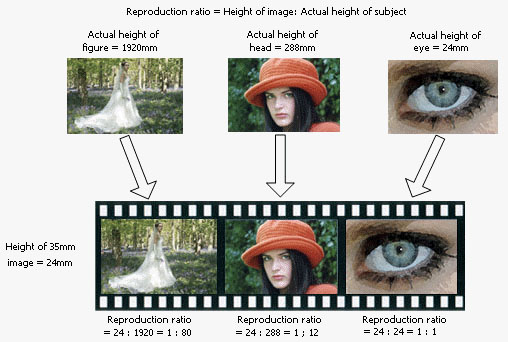Many photographers find it difficult to keep track of depth of field as they work. They move around a subject and the focused distance changes. They may also alter the aperture and focal length of the lens. Depth of field scales marked on lenses certainly help, but reading them interrupts the flow of work. Preview facilities, that close lenses down to chosen apertures, are intended to make depth of field visible through the viewfinder but consequently reduce the brightness of the eyepiece image. Some people can cope with these things – others cannot. One possible solution is to use reproduction ratio.
This is a very simple but little-used measurement. The eyes of some first-class photographers glaze over at the very mention of the term. This is surprising because even rudimentary understanding is useful in a practical way.

Depth of field depends principally upon three variables - aperture, focal length and focused distance. It is nevertheless beyond most of us to do the mental arithmetic on the fly. Fortunately two of the variables, focal length and focused distance, combine to give reproduction ration. This is the ratio of the size of the subject’s image on film or sensor to the actual physical dimensions of the subject, a product quantified simply by observing how large the subject appears in the viewfinder.
Consider an example. If a person's head comfortably fills a landscape-format full-frame DSLR or 35mm frame, using any lens, the image is about 24mm in height. If we assume for convenience that a human head is actually 288mm in height, the reproduction ratio is 24:288 or 1:12. Since lens manufacturers quote depth of field figures for given reproduction ratios and apertures, all the brain has to do is track aperture and memorize the corresponding depth of field.
There is nothing clever about this. When working close to a subject just remember, for instance, that when a person's head fills a horizontal full-frame DSLR or 35mm frame the reproduction ratio is 1:12. At f/5.6 this gives depth of field of about five centimetres. It is as simple as that - forget about lenses, zooming and distances.
Now lets look at reproduction ratio a little more precisely. As we have seen, reproduction ratio, or magnification, is the ratio of the size of the subject in an image to the actual size of the real subject. The measurements used are those of the real subject in the plane of critical focus and of the corresponding image, when both the image and subject planes are parallel. Reproduction ratio can also be calculated using the perpendicular distance between the image plane and the centre of lens as a fraction of the perpendicular distance between the real subject plane and the centre of the lens (ie the distances to the rear and front nodal points).
As equations:
- R = P/S
- R = 1/(S/F - 1)
- R = P/F - 1
- R = (P - F)/F
- R = F/(S - F)
where R is the reproduction ratio, S is the distance to the subject, P is the distance to the image and F is the focal length of the lens.